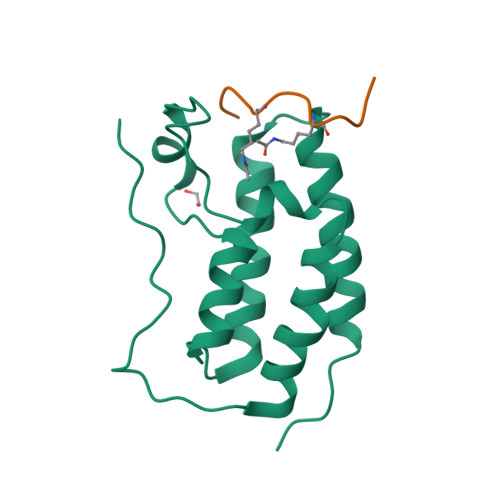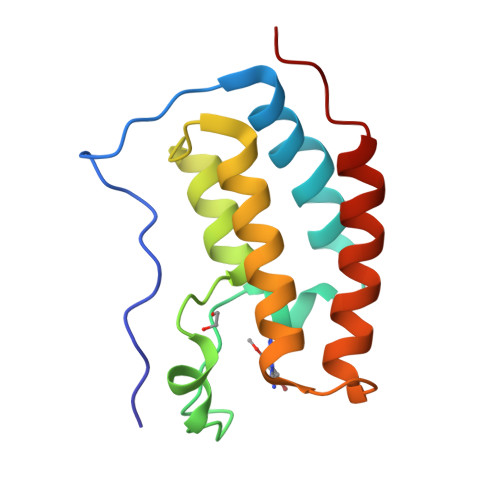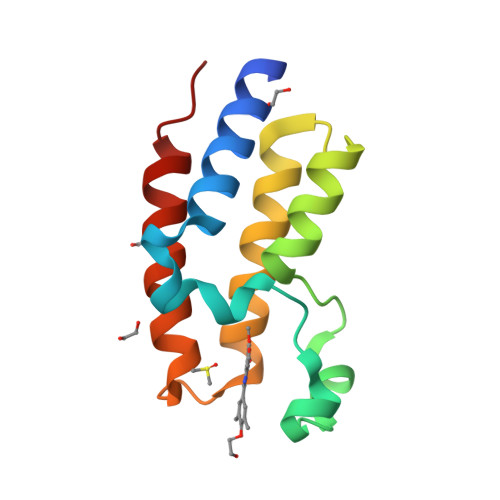bromodomain containing 4
Target not currently curated in GtoImmuPdb
Target id: 1945
Nomenclature: bromodomain containing 4
Abbreviated Name: BRD4
Family: Bromodomain kinase (BRDK) family
Contents:
Gene and Protein Information  |
||||||
| Species | TM | AA | Chromosomal Location | Gene Symbol | Gene Name | Reference |
| Human | - | 1362 | 19p13.12 | BRD4 | bromodomain containing 4 | |
| Mouse | - | 1400 | 17 17.39 cM | Brd4 | bromodomain containing 4 | |
| Rat | - | 1403 | 7 q11 | Brd4 | bromodomain containing 4 | |
Previous and Unofficial Names  |
| CAP | chromosome-associated protein | HUNK1 | MCAP | Mitotic chromosome-associated protein |
Selected 3D Structures  |
|||||||||||||

|
|
||||||||||||

|
|
||||||||||||

|
|
||||||||||||

|
|
||||||||||||

|
|
||||||||||||

|
|
||||||||||||

|
|
||||||||||||
Enzyme Reaction  |
||||
|
||||
Download all structure-activity data for this target as a CSV file 
| Inhibitors | |||||||||||||||||||||||||||||||||||||||||||||||||||||||||||||||||||||||||||||||||||||||||||||||||||||||||||||||||||||||||||||||||||||||||||||||||||||||||||||||||||||||||||||||||||||||||||||||||||||||||||||||||||||||||||||||||||||||||||||||||||||||||||||||||||||||||||||||||||||||||||||||||||||||||||||||||||||||||||||||||||||||||||||||||||||||||||||||||||||||||||||||||||||||||||||||||||||||||||||||||||||||||||||||||||||||||||||||||||||||||||||||||||||||||||||||||||||||||||||||||||||||||||||||||||||||||||||||||||||||||||||||||||||||||||||||||||||||||||||||||||||||||||||||||||||||||||||||||||||||||||||||||||||||||||||||||||||||||||||||||||||||||||||||||||||||||||||||||||||||||||||||||||||||||||||||||||||||||||||||||||||||||||||||||||||||||||||||||||||||||||||||||||||||||||||||||||||||||||||||||||||||||||||||||||||||||||||||||||||||||||||||||||||||||||||||||||||||||||||||||||||||||||||||||||||||||||||||||||||||||||||||||||||||||||||||||||||||||||||||||||||||||||||||||||||||||||||||||||||||
| Key to terms and symbols | View all chemical structures | Click column headers to sort | |||||||||||||||||||||||||||||||||||||||||||||||||||||||||||||||||||||||||||||||||||||||||||||||||||||||||||||||||||||||||||||||||||||||||||||||||||||||||||||||||||||||||||||||||||||||||||||||||||||||||||||||||||||||||||||||||||||||||||||||||||||||||||||||||||||||||||||||||||||||||||||||||||||||||||||||||||||||||||||||||||||||||||||||||||||||||||||||||||||||||||||||||||||||||||||||||||||||||||||||||||||||||||||||||||||||||||||||||||||||||||||||||||||||||||||||||||||||||||||||||||||||||||||||||||||||||||||||||||||||||||||||||||||||||||||||||||||||||||||||||||||||||||||||||||||||||||||||||||||||||||||||||||||||||||||||||||||||||||||||||||||||||||||||||||||||||||||||||||||||||||||||||||||||||||||||||||||||||||||||||||||||||||||||||||||||||||||||||||||||||||||||||||||||||||||||||||||||||||||||||||||||||||||||||||||||||||||||||||||||||||||||||||||||||||||||||||||||||||||||||||||||||||||||||||||||||||||||||||||||||||||||||||||||||||||||||||||||||||||||||||||||||||||||||||||||||||||||||||||
|
|||||||||||||||||||||||||||||||||||||||||||||||||||||||||||||||||||||||||||||||||||||||||||||||||||||||||||||||||||||||||||||||||||||||||||||||||||||||||||||||||||||||||||||||||||||||||||||||||||||||||||||||||||||||||||||||||||||||||||||||||||||||||||||||||||||||||||||||||||||||||||||||||||||||||||||||||||||||||||||||||||||||||||||||||||||||||||||||||||||||||||||||||||||||||||||||||||||||||||||||||||||||||||||||||||||||||||||||||||||||||||||||||||||||||||||||||||||||||||||||||||||||||||||||||||||||||||||||||||||||||||||||||||||||||||||||||||||||||||||||||||||||||||||||||||||||||||||||||||||||||||||||||||||||||||||||||||||||||||||||||||||||||||||||||||||||||||||||||||||||||||||||||||||||||||||||||||||||||||||||||||||||||||||||||||||||||||||||||||||||||||||||||||||||||||||||||||||||||||||||||||||||||||||||||||||||||||||||||||||||||||||||||||||||||||||||||||||||||||||||||||||||||||||||||||||||||||||||||||||||||||||||||||||||||||||||||||||||||||||||||||||||||||||||||||||||||||||||||||||||
| Inhibitor Comments | |||||||||||||||||||||||||||||||||||||||||||||||||||||||||||||||||||||||||||||||||||||||||||||||||||||||||||||||||||||||||||||||||||||||||||||||||||||||||||||||||||||||||||||||||||||||||||||||||||||||||||||||||||||||||||||||||||||||||||||||||||||||||||||||||||||||||||||||||||||||||||||||||||||||||||||||||||||||||||||||||||||||||||||||||||||||||||||||||||||||||||||||||||||||||||||||||||||||||||||||||||||||||||||||||||||||||||||||||||||||||||||||||||||||||||||||||||||||||||||||||||||||||||||||||||||||||||||||||||||||||||||||||||||||||||||||||||||||||||||||||||||||||||||||||||||||||||||||||||||||||||||||||||||||||||||||||||||||||||||||||||||||||||||||||||||||||||||||||||||||||||||||||||||||||||||||||||||||||||||||||||||||||||||||||||||||||||||||||||||||||||||||||||||||||||||||||||||||||||||||||||||||||||||||||||||||||||||||||||||||||||||||||||||||||||||||||||||||||||||||||||||||||||||||||||||||||||||||||||||||||||||||||||||||||||||||||||||||||||||||||||||||||||||||||||||||||||||||||||||||
| Zhang et al. (2012) also report an IC50 for MS417 at BRD4-BD2 of 46nM [38]. | |||||||||||||||||||||||||||||||||||||||||||||||||||||||||||||||||||||||||||||||||||||||||||||||||||||||||||||||||||||||||||||||||||||||||||||||||||||||||||||||||||||||||||||||||||||||||||||||||||||||||||||||||||||||||||||||||||||||||||||||||||||||||||||||||||||||||||||||||||||||||||||||||||||||||||||||||||||||||||||||||||||||||||||||||||||||||||||||||||||||||||||||||||||||||||||||||||||||||||||||||||||||||||||||||||||||||||||||||||||||||||||||||||||||||||||||||||||||||||||||||||||||||||||||||||||||||||||||||||||||||||||||||||||||||||||||||||||||||||||||||||||||||||||||||||||||||||||||||||||||||||||||||||||||||||||||||||||||||||||||||||||||||||||||||||||||||||||||||||||||||||||||||||||||||||||||||||||||||||||||||||||||||||||||||||||||||||||||||||||||||||||||||||||||||||||||||||||||||||||||||||||||||||||||||||||||||||||||||||||||||||||||||||||||||||||||||||||||||||||||||||||||||||||||||||||||||||||||||||||||||||||||||||||||||||||||||||||||||||||||||||||||||||||||||||||||||||||||||||||||
| Antagonists | |||||||||||||||||||||||||||||||||||||||||||||||||||
| Key to terms and symbols | View all chemical structures | Click column headers to sort | |||||||||||||||||||||||||||||||||||||||||||||||||
|
|||||||||||||||||||||||||||||||||||||||||||||||||||
| Immuno Process Associations | ||
|
||
|
| General Comments |
|
BRD4 has been reported to act as an atypical kinase, phosphorylating Ser2 present in the C-terminal domain (CTD) of RNA polymerase II, highlighting a direct role of BRD4 in transcription [7]. In certain cancers aberrant BRD4 expression mediates carcinigogenesis by hyperacetylationg the chromatin of genes involved in promoting cell proliferation. As a result, BRD4 inhibitors (and inhibitors of other BET family proteins) are being developed and investigated for therapeutic anti-cancer potential [30,33]. SARS-CoV-2/COVID-19 Experimental in vitro evidence, using affinity-purification mass spectrometry (AP-MS), indicates a protein-protein interaction between BRD2/4 and the SARS-CoV-2 envelope protein (E) [16], although whether this interaction is realistic based on spatial distribution of the host and viral proteins within cells was not addressed in this study. Speculatively, BRD inhibitors such as JQ1 and RVX 208, or BRD degraders (PROTACs; e.g. dBET6 or MZ1) could be utilised to examine the effect of inhibiting the BRD2/4-E interaction on SARS-CoV-2 pathobiology. |
References
1. Albrecht BK, Gehling VS, Hewitt MC, Vaswani RG, Côté A, Leblanc Y, Nasveschuk CG, Bellon S, Bergeron L, Campbell R et al.. (2016) Identification of a Benzoisoxazoloazepine Inhibitor (CPI-0610) of the Bromodomain and Extra-Terminal (BET) Family as a Candidate for Human Clinical Trials. J Med Chem, 59 (4): 1330-9. [PMID:26815195]
2. Chan KH, Zengerle M, Testa A, Ciulli A. (2018) Impact of Target Warhead and Linkage Vector on Inducing Protein Degradation: Comparison of Bromodomain and Extra-Terminal (BET) Degraders Derived from Triazolodiazepine (JQ1) and Tetrahydroquinoline (I-BET726) BET Inhibitor Scaffolds. J Med Chem, 61 (2): 504-513. [PMID:28595007]
3. Chung CW, Coste H, White JH, Mirguet O, Wilde J, Gosmini RL, Delves C, Magny SM, Woodward R, Hughes SA et al.. (2011) Discovery and characterization of small molecule inhibitors of the BET family bromodomains. J Med Chem, 54 (11): 3827-38. [PMID:21568322]
4. Ciceri P, Müller S, O'Mahony A, Fedorov O, Filippakopoulos P, Hunt JP, Lasater EA, Pallares G, Picaud S, Wells C et al.. (2014) Dual kinase-bromodomain inhibitors for rationally designed polypharmacology. Nat Chem Biol, 10 (4): 305-12. [PMID:24584101]
5. Dawson MA, Prinjha RK, Dittmann A, Giotopoulos G, Bantscheff M, Chan WI, Robson SC, Chung CW, Hopf C, Savitski MM et al.. (2011) Inhibition of BET recruitment to chromatin as an effective treatment for MLL-fusion leukaemia. Nature, 478 (7370): 529-33. [PMID:21964340]
6. Demont EH, Bamborough P, Chung CW, Craggs PD, Fallon D, Gordon LJ, Grandi P, Hobbs CI, Hussain J, Jones EJ et al.. (2014) 1,3-Dimethyl Benzimidazolones Are Potent, Selective Inhibitors of the BRPF1 Bromodomain. ACS Med Chem Lett, 5 (11): 1190-1195. [PMID:25408830]
7. Devaiah BN, Lewis BA, Cherman N, Hewitt MC, Albrecht BK, Robey PG, Ozato K, Sims 3rd RJ, Singer DS. (2012) BRD4 is an atypical kinase that phosphorylates serine2 of the RNA polymerase II carboxy-terminal domain. Proc Natl Acad Sci USA, 109 (18): 6927-32. [PMID:22509028]
8. Dittmann A, Werner T, Chung CW, Savitski MM, Fälth Savitski M, Grandi P, Hopf C, Lindon M, Neubauer G, Prinjha RK et al.. (2014) The commonly used PI3-kinase probe LY294002 is an inhibitor of BET bromodomains. ACS Chem Biol, 9 (2): 495-502. [PMID:24533473]
9. Engelhardt H, Gianni D, Smethurst C. (2016) Substituted [1,2,4]triazolo[4,3-A]pyrazines that are BRD4 inhibitors. Patent number: US9266891B2. Assignee: Boehringer Ingelheim International GmbH. Priority date: 16/11/2012. Publication date: 23/02/2016.
10. Filippakopoulos P, Picaud S, Fedorov O, Keller M, Wrobel M, Morgenstern O, Bracher F, Knapp S. (2012) Benzodiazepines and benzotriazepines as protein interaction inhibitors targeting bromodomains of the BET family. Bioorg Med Chem, 20 (6): 1878-86. [PMID:22137933]
11. Filippakopoulos P, Picaud S, Mangos M, Keates T, Lambert JP, Barsyte-Lovejoy D, Felletar I, Volkmer R, Müller S, Pawson T et al.. (2012) Histone recognition and large-scale structural analysis of the human bromodomain family. Cell, 149 (1): 214-31. [PMID:22464331]
12. Filippakopoulos P, Qi J, Picaud S, Shen Y, Smith WB, Fedorov O, Morse EM, Keates T, Hickman TT, Felletar I et al.. (2010) Selective inhibition of BET bromodomains. Nature, 468 (7327): 1067-73. [PMID:20871596]
13. Fish PV, Filippakopoulos P, Bish G, Brennan PE, Bunnage ME, Cook AS, Federov O, Gerstenberger BS, Jones H, Knapp S et al.. (2012) Identification of a chemical probe for bromo and extra C-terminal bromodomain inhibition through optimization of a fragment-derived hit. J Med Chem, 55 (22): 9831-7. [PMID:23095041]
14. Gavai AV, Fink BE, Fairfax DJ, Martin GS, Rossiter LM, Holst CL, Kim SH, Leavitt KJ, Mastalerz H, Han WC et al.. (2009) Discovery and preclinical evaluation of [4-[[1-(3-fluorophenyl)methyl]-1H-indazol-5-ylamino]-5-methylpyrrolo[2,1-f][1,2,4]triazin-6-yl]carbamic acid, (3S)-3-morpholinylmethyl ester (BMS-599626), a selective and orally efficacious inhibitor of human epidermal growth factor receptor 1 and 2 kinases. J Med Chem, 52 (21): 6527-30. [PMID:19821562]
15. Gehling VS, Hewitt MC, Vaswani RG, Leblanc Y, Côté A, Nasveschuk CG, Taylor AM, Harmange JC, Audia JE, Pardo E et al.. (2013) Discovery, Design, and Optimization of Isoxazole Azepine BET Inhibitors. ACS Med Chem Lett, 4 (9): 835-40. [PMID:24900758]
16. Gordon DE, Jang GM, Bouhaddou M, Xu J, Obernier K, White KM, O'Meara MJ, Rezelj VV, Guo JZ, Swaney DL et al.. (2020) A SARS-CoV-2 protein interaction map reveals targets for drug repurposing. Nature, 583 (7816): 459-468. [PMID:32353859]
17. Hay D, Fedorov O, Filippakopoulos P, Martin S, Philpott M, Picaud S, Hewings DS, Uttakar S, Heightman TD, Conway SJ et al.. (2013) The design and synthesis of 5- and 6-isoxazolylbenzimidazoles as selective inhibitors of the BET bromodomains. Medchemcomm, 4 (1): 140-144.
18. Hewings DS, Fedorov O, Filippakopoulos P, Martin S, Picaud S, Tumber A, Wells C, Olcina MM, Freeman K, Gill A et al.. (2013) Optimization of 3,5-dimethylisoxazole derivatives as potent bromodomain ligands. J Med Chem, 56 (8): 3217-27. [PMID:23517011]
19. Hewings DS, Wang M, Philpott M, Fedorov O, Uttarkar S, Filippakopoulos P, Picaud S, Vuppusetty C, Marsden B, Knapp S et al.. (2011) 3,5-dimethylisoxazoles act as acetyl-lysine-mimetic bromodomain ligands. J Med Chem, 54 (19): 6761-70. [PMID:21851057]
20. Hu R, Wang WL, Yang YY, Hu XT, Wang QW, Zuo WQ, Xu Y, Feng Q, Wang NY. (2022) Identification of a selective BRD4 PROTAC with potent antiproliferative effects in AR-positive prostate cancer based on a dual BET/PLK1 inhibitor. Eur J Med Chem, 227: 113922. [PMID:34700270]
21. Jones KL, Beaumont DM, Bernard SG, Bit RA, Campbell SP, Chung CW, Cutler L, Demont EH, Dennis K, Gordon L et al.. (2021) Discovery of a Novel Bromodomain and Extra Terminal Domain (BET) Protein Inhibitor, I-BET282E, Suitable for Clinical Progression. J Med Chem, 64 (16): 12200-12227. [PMID:34387088]
22. Li X, Zhang J, Zhao L, Yang Y, Zhang H, Zhou J. (2018) Design, Synthesis, and in vitro Biological Evaluation of 3,5-Dimethylisoxazole Derivatives as BRD4 Inhibitors. ChemMedChem, 13 (13): 1363-1368. [PMID:29808961]
23. Liu S, Yosief HO, Dai L, Huang H, Dhawan G, Zhang X, Muthengi AM, Roberts J, Buckley DL, Perry JA et al.. (2018) Structure-Guided Design and Development of Potent and Selective Dual Bromodomain 4 (BRD4)/Polo-like Kinase 1 (PLK1) Inhibitors. J Med Chem, 61 (17): 7785-7795. [PMID:30125504]
24. Lucas SCC, Atkinson SJ, Chung CW, Davis R, Gordon L, Grandi P, Gray JJR, Grimes T, Phillipou A, Preston AG et al.. (2021) Optimization of a Series of 2,3-Dihydrobenzofurans as Highly Potent, Second Bromodomain (BD2)-Selective, Bromo and Extra-Terminal Domain (BET) Inhibitors. J Med Chem, 64 (15): 10711-10741. [PMID:34260229]
25. Lucas X, Wohlwend D, Hügle M, Schmidtkunz K, Gerhardt S, Schüle R, Jung M, Einsle O, Günther S. (2013) 4-Acyl pyrroles: mimicking acetylated lysines in histone code reading. Angew Chem Int Ed Engl, 52 (52): 14055-9. [PMID:24272870]
26. McLure KG, Gesner EM, Tsujikawa L, Kharenko OA, Attwell S, Campeau E, Wasiak S, Stein A, White A, Fontano E et al.. (2013) RVX-208, an inducer of ApoA-I in humans, is a BET bromodomain antagonist. PLoS ONE, 8 (12): e83190. [PMID:24391744]
27. Mirguet O, Lamotte Y, Chung CW, Bamborough P, Delannée D, Bouillot A, Gellibert F, Krysa G, Lewis A, Witherington J et al.. (2014) Naphthyridines as novel BET family bromodomain inhibitors. ChemMedChem, 9 (3): 580-9. [PMID:24000170]
28. Picaud S, Strocchia M, Terracciano S, Lauro G, Mendez J, Daniels DL, Riccio R, Bifulco G, Bruno I, Filippakopoulos P. (2015) 9H-Purine Scaffold Reveals Induced-Fit Pocket Plasticity of the BRD9 Bromodomain. J Med Chem, 58 (6): 2718-36. [PMID:25703523]
29. Picaud S, Wells C, Felletar I, Brotherton D, Martin S, Savitsky P, Diez-Dacal B, Philpott M, Bountra C, Lingard H et al.. (2013) RVX-208, an inhibitor of BET transcriptional regulators with selectivity for the second bromodomain. Proc Natl Acad Sci USA, 110 (49): 19754-9. [PMID:24248379]
30. Pérez-Salvia M, Esteller M. (2017) Bromodomain inhibitors and cancer therapy: From structures to applications. Epigenetics, 12 (5): 323-339. [PMID:27911230]
31. Raina K, Lu J, Qian Y, Altieri M, Gordon D, Rossi AM, Wang J, Chen X, Dong H, Siu K et al.. (2016) PROTAC-induced BET protein degradation as a therapy for castration-resistant prostate cancer. Proc Natl Acad Sci USA, 113 (26): 7124-9. [PMID:27274052]
32. Shortt J, Hsu AK, Martin BP, Doggett K, Matthews GM, Doyle MA, Ellul J, Jockel TE, Andrews DM, Hogg SJ et al.. (2014) The drug vehicle and solvent N-methylpyrrolidone is an immunomodulator and antimyeloma compound. Cell Rep, 7 (4): 1009-19. [PMID:24813887]
33. Taniguchi Y. (2016) The Bromodomain and Extra-Terminal Domain (BET) Family: Functional Anatomy of BET Paralogous Proteins. Int J Mol Sci, 17 (11). [PMID:27827996]
34. Wang L, Pratt JK, Mcdaniel KF, Dai Y, Fidanze SD, Hasvold L, Holms JH, Kati WM, Liu D, Mantei RA et al.. (2013) Bromodomain inhibitors. Patent number: WO2013097601. Assignee: Abbvie Inc., Abbott Laboratories Trading (Shanghai) Company, Ltd.. Priority date: 30/12/2011. Publication date: 04/07/2013.
35. Wang NY, Xu Y, Xiao KJ, Zuo WQ, Zhu YX, Hu R, Wang WL, Shi YJ, Yu LT, Liu ZH. (2020) Design, synthesis, and biological evaluation of 4,5-dihydro-[1,2,4]triazolo[4,3-f]pteridine derivatives as novel dual-PLK1/BRD4 inhibitors. Eur J Med Chem, 191: 112152. [PMID:32088495]
36. Winter GE, Mayer A, Buckley DL, Erb MA, Roderick JE, Vittori S, Reyes JM, di Iulio J, Souza A, Ott CJ et al.. (2017) BET Bromodomain Proteins Function as Master Transcription Elongation Factors Independent of CDK9 Recruitment. Mol Cell, 67 (1): 5-18.e19. [PMID:28673542]
37. Yin M, Guo Y, Hu R, Cai WL, Li Y, Pei S, Sun H, Peng C, Li J, Ye R et al.. (2020) Potent BRD4 inhibitor suppresses cancer cell-macrophage interaction. Nat Commun, 11 (1): 1833. [PMID:32286255]
38. Zhang G, Liu R, Zhong Y, Plotnikov AN, Zhang W, Zeng L, Rusinova E, Gerona-Nevarro G, Moshkina N, Joshua J et al.. (2012) Down-regulation of NF-κB transcriptional activity in HIV-associated kidney disease by BRD4 inhibition. J Biol Chem, 287 (34): 28840-51. [PMID:22645123]
39. Zhang G, Plotnikov AN, Rusinova E, Shen T, Morohashi K, Joshua J, Zeng L, Mujtaba S, Ohlmeyer M, Zhou MM. (2013) Structure-guided design of potent diazobenzene inhibitors for the BET bromodomains. J Med Chem, 56 (22): 9251-64. [PMID:24144283]
40. Zhao C, Zhang Y, Zhang J, Li S, Liu M, Geng Y, Liu F, Chai Q, Meng H, Li M et al.. (2023) Discovery of Novel Fedratinib-Based HDAC/JAK/BRD4 Triple Inhibitors with Remarkable Antitumor Activity against Triple Negative Breast Cancer. J Med Chem, 66 (20): 14150-14174. [PMID:37796543]
How to cite this page
Bromodomain kinase (BRDK) family: bromodomain containing 4. Last modified on 06/10/2023. Accessed on 19/04/2024. IUPHAR/BPS Guide to PHARMACOLOGY, https://www.guidetoimmunopharmacology.org/GRAC/ObjectDisplayForward?objectId=1945.












